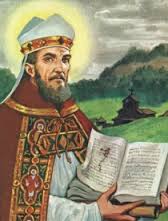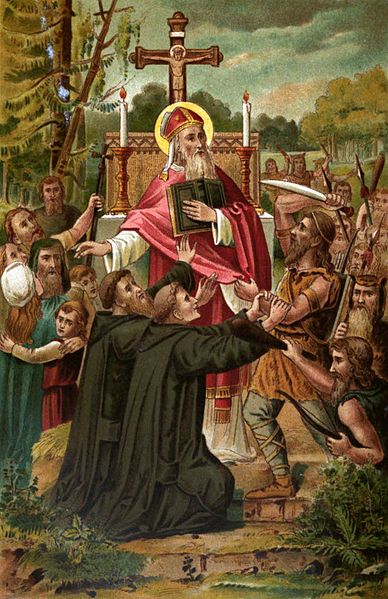
Summary: St Boniface, (2) , martyr: an English monk from Exeter, he evangelised first among the Frisians (Holland), then visited Pope Gregory II in Rome, and then had a very successful apostolate across north-western Europe.
Desmond O’Grady tells his story
 In the spring of AD 718 a blonde emaciated, pale-complexioned monk in a Benedictine habit reached the Pope’s Roman residence, the Lateran, seeking an audience. The visitor, called Wynfrith, who had entered the monastery in Exeter at the age of seven was to be one of the makers of Christian Europe. After studying in Exeter he became an eminent teacher in the monastery, where he composed poetry and innumerable riddles and wrote a Latin grammar, but, at the age of forty, conscious of his Saxon descent, he felt called to minister to the Saxon pagans in their German homeland.
In the spring of AD 718 a blonde emaciated, pale-complexioned monk in a Benedictine habit reached the Pope’s Roman residence, the Lateran, seeking an audience. The visitor, called Wynfrith, who had entered the monastery in Exeter at the age of seven was to be one of the makers of Christian Europe. After studying in Exeter he became an eminent teacher in the monastery, where he composed poetry and innumerable riddles and wrote a Latin grammar, but, at the age of forty, conscious of his Saxon descent, he felt called to minister to the Saxon pagans in their German homeland.
Mission to the Dutch
But first, for a few months, the lad joined another Anglo-Saxon monk, Willibrord, in his mission to the Frisians (the Dutch). That mission had not been very fruitul, partly because the Frisians were warring with the Catholic Franks. When Wynfrith returned to his monastery in Wessex a bishop convinced him that he needed papal backing to have missionary success.
Pope Gregory II probed the Benedictine’s scriptural knowledge and political acumen for months before approving his mission. It meant a new life and Gregory gave the monk a new name, Boniface. Boniface set to work in Thuringa and Hesse where some missionaries had already been in action but he reported to Rome that the Church was lax and that the priests he met, many of them Anglo-Saxon, were ignorant. Some sacrificed to the pagan god, Thor; some baptized in the name of the Fatherland, the Daughter and the Holy Spirit. Many of them had concubines.
Signs of Corruption
After four years Gregory asked Boniface to return to Rome where he made him, at the age of fifty, bishop for all Germany and directly responsible to the Pope. Snow blocking the Brenner Pass prevented his return until spring. When he left he took a papal letter to Charles Martel, the most powerful figure among the Franks who had recently beaten the Muslms at Poitiers, threatening Western Europe.
Boniface was well received by Martel but was shocked by the crudity of his soldiers and far more by the avaricious, immoral court prelates. More interested in hunting and fighting than in priestly duties, they sometimes celebrated Mass in hunting garb. By exploiting the poor and using Church property, these gluttonous, drunken men lived sumptuously and amused themselves by playing dice, which was expressly forbidden. Some had mistresses and had fathered illegitimate children.
Efforts at reform
 Shortly after leaving Martel’s court, Boniface came across some pagans lying prostrate before a sacred giant oak on a mountain in Hesse. Boniface held a cross high as two monks felled the tree. The pagans warned of the wrath of the god, Thor, but he remained silent. From the tree’s wood Boniface built a chapel dedicated to St Peter and shortly after built nearby a monastery, one of a series which were centres of learning but also economic powerhouses because of the monks’ agricultural know-how.
Shortly after leaving Martel’s court, Boniface came across some pagans lying prostrate before a sacred giant oak on a mountain in Hesse. Boniface held a cross high as two monks felled the tree. The pagans warned of the wrath of the god, Thor, but he remained silent. From the tree’s wood Boniface built a chapel dedicated to St Peter and shortly after built nearby a monastery, one of a series which were centres of learning but also economic powerhouses because of the monks’ agricultural know-how.
In response to Boniface’s queries Rome supplied answers on what should be done with food offered to idols, the remarriage of widows, whether a spouse’s sickness affected marital rights and how to handle ‘unworthy bishops and priests full of vice’.
Gregory II died in AD 731. His successor, Gregory III, supported Boniface against those bishops who opposed him because he was too rigorous. Gregory III’s successor, Zachary, gave Boniface a free hand to hold a synod of the lax Frankish church (In many places, he had written to Zachary, ‘episcopal sees are assigned to greedy laymen or corrupt clergy’) and depose unworthy bishops and priests. Boniface held a synod but clerical hostility to him continued.
On the death of Charles Martel, his son Pepin asked Pope Zachary’s assent to a coup d’etat. The inept King Childeric III was packed off to a monastery and in November A.D. 751, at Soissons near Paris, Boniface as papal legate poured oil on the head of Pepin to show he was King of the Franks ‘with the Lord’s aid’. Pepin was the first Westerner to receive such a consecration.
Archbishop of Mainz
It meant a strong power well-disposed to the Church in the vast area from the Atlantic to the Elbe, from the Pyrenees to the Danube. It also meant that Rome had an ally against the threatening Lombard King, Astolf. It probably meant also that some of the Franks’ enemies could not distinguish between them and the Church.
Boniface, who was by this stage Archbishop of Mainz (opposition from local clergy prevented him from being appointed Archbishop of Cologne) kept asking Pope Zachary for guidance on questions such as the attitude to lepers, what made it possible to ordain priests under the normal age of thirty and what should be done about a new people who had arrived at the frontier asking to live in Christian lands – the Slavs.
Zachary said he wanted time to think about that but he did not have much time left: he died on 15th March 752. His successor, Stephen II, received a tardy letter of homage from Boniface who explained that thirty churches and monasteries had been destroyed by barbarians. Perhaps they identified the Church with the civil power.

Stephen himself came to what is now France to obtain Pepin’s military support against the Lombards and recognition of what were to become the papal States. Boniface had made an essential contribution to the alliance with the Franks. But this scrupulous, dedicated monk, who was later called the Apostle of the Germans, did not retire to rest on his laurels and await his death at the huge monastery he had established at Fulda.
Martyrdom at eighty
At the age of eighty, after forty years as a missionary, he set out again along the Rhine with fifty-two men: priests, monks, deacons, novices; servants and ten soldiers. Nothing if not tenacious, he wanted to complete the conversion of the Frisians and of his Saxons. In Frisian territory, he arranged a big meeting of converts near the Zuidersee but, just before they arrived, Boniface’s camp was overrun by brigands who slaughtered him and his many companions.
This article first appeared in The Messenger (June 1998), a publication of the Irish Jesuits.